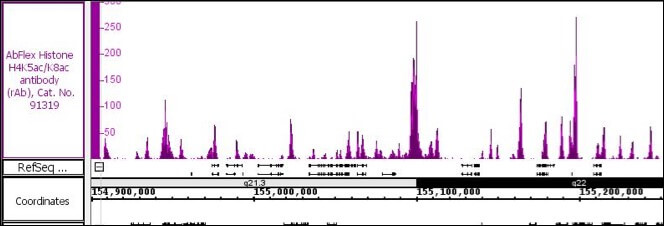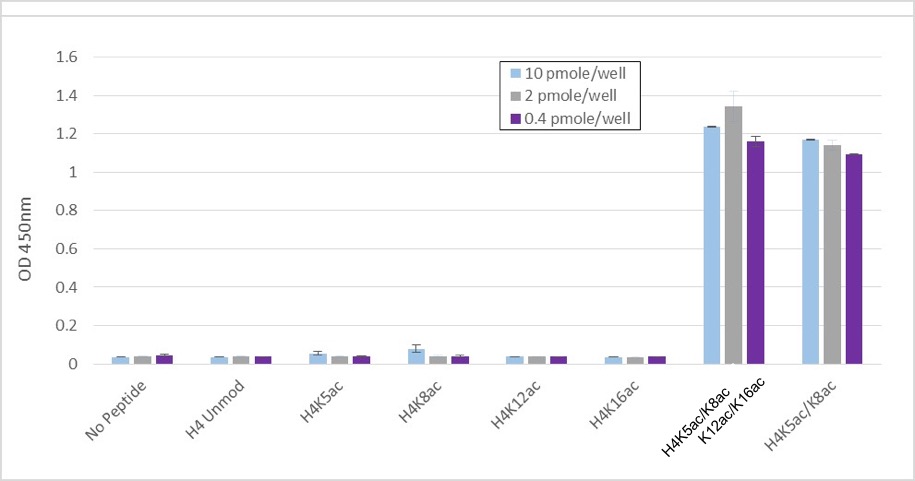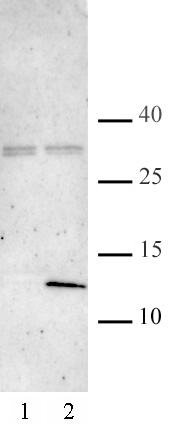AbFlex Histone H4K5ac/K8ac antibody (rAb)
Host / Isotype
Mouse / IgG1
Reactivity
Wide Range Predicted
Applications
WB, ELISA, ChIP, Dot Blot, ChIP-Seq
Cat No : 91319,91320 91319
Synonyms
验证数据展示
产品信息
| Tested Applications |
WB, ELISA, ChIP, Dot Blot, ChIP-Seq
Applications Validated by Active Motif: ChIP-Seq: 4 ug per ChIP WB*: 0.5 – 2 ug/ml DB: 0.5 ug/ml *Note: Many chromatin-bound proteins are not soluble in a low salt nuclear extract and fractionate to the pellet. Therefore, we recommend a High Salt / Sonication Protocol when preparing nuclear extracts for Western blot. |
| Tested Reactivity | Wide Range Predicted |
| Host / Isotype | Mouse / IgG1 |
| Class | Recombinant |
| Type | Antibody |
| Modification | Acetylated |
| Immunogen | This antibody was raised against a full-length human H4 protein containing acetyl K5 and K8 (H4K5acK8ac). |
| Full Name | AbFlex Histone H4K5ac/K8ac antibody (rAb) |
| Synonyms | H4K5ac, K8ac, acetylated Lysine 5, acetylated Lysine 8, ChIP |
| Molecular weight | 12 kDa |
| GenBank accession number | NP_778224 | Purification Method | Protein A Chromatography |
| Buffer | 140 mM Hepes, pH 7.5, 70 mM NaCl, 32 mM NaOAc, 0.035% sodium azide, and 30% glycerol. Sodium azide is highly toxic. |
| Storage | Some products may be shipped at room temperature. This will not affect their stability or performance. Avoid repeated freeze/thaw cycles by aliquoting items into single-use fractions for storage at -20°C for up to 2 years. Keep all reagents on ice when not in storage. |
背景介绍
AbFlex antibodies are recombinant antibodies (rAbs) that have been generated using defined DNA sequences to produce highly specific, reproducible antibodies. Each AbFlex antibody contains a 6xHis Tag, a Biotinylation Tag for enzymatic biotin conjugation using the biotin ligase, BirA, and a sortase recognition motif (LPXTG) to attach a variety of labels directly to the antibody including fluorophores, enzymatic substrates (HRP, AP), peptides, drugs as well as solid supports. AbFlex Histone H4K5ac/K8ac antibody was expressed in 293 cells and contains mouse immunoglobulin heavy and light chains. Histone H4 is one of the core components of the nucleosome. The nucleosome is the smallest subunit of chromatin and consists of 147 base pairs of DNA wrapped around an octamer of core histone proteins (two each of Histone H2A, Histone H2B, Histone H3 and Histone H4). Histone H1 is a linker histone, present at the interface between the nucleosome core and DNA entry/exit points; it is responsible for establishing higher-order chromatin structure. Chromatin is subject to a variety of chemical modifications, including post-translational modifications of the histone proteins and the methylation of cytosine residues in the DNA. Reported histone modifications include acetylation, methylation, phosphorylation, ubiquitylation, glycosylation, ADP-ribosylation, carbonylation and SUMOylation; they play a major role in regulating gene expression. Lysine N-e-acetylation is a dynamic, reversible and tightly regulated protein and histone modification that plays a major role in chromatin remodeling and in the regulation of gene expression in various cellular functions. Histone H4 molecules acetylated at Lys5 or Lys8 are distributed in overlapping, but non-identical, islands throughout the euchromatic chromosome arms.



